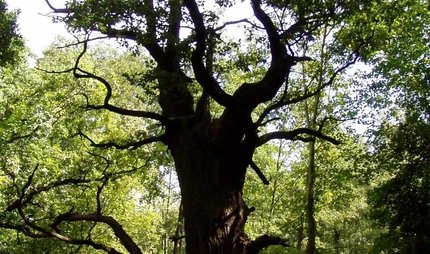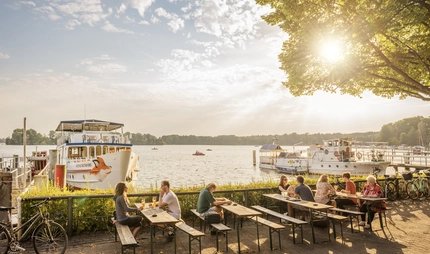
Berlin’s tranquil and leafy side
From Frohnau via Heiligensee to Tegel
Take a break – with its refined beauty and rural tranquillity, the northern part of Reinickendorf is reminiscent of a typical English garden suburb. On the quiet squares around the Frohnau neighbourhood and at the Buddhistisches Haus you can enjoy peace and quiet without leaving Berlin. Did you know that the name Frohnau was chosen from a competition in 1909 and derives from “Frohe Aue” – “Happy Meadow”? The centrepiece of Frohnau garden suburb is the Art Deco railway station, as well as Zeltinger Platz and Ludolfingerplatz. Created between 1910 and 1912 by the landscape architect Ludwig Lesser, the two squares are connected by a bridge.
Casino Turm in Frohnau
We recommend going up Frohnau’s most famous landmark, the 30-metre-high Casino Turm, and enjoying the view. The square next to it features an avenue of white-blossoming horse chestnut trees framed by a vine-covered pergola. If you walk past the former polo field into the woods called Frohnauer Forst, you’ll discover a picturesque artists’ house from the 20th century. The works created there are exhibited once a year on open day. Continuing on towards the former border along the Mauerweg, directly on the state boundary of Berlin you come to the Invalidensiedlung. The settlement is the one of the oldest care facilities for wounded veterans in the German-speaking countries and can look back on a 250-year history. It was built as accommodation and hospitals, and its characteristic architecture is reminiscent of the Dutch Quarter in Potsdam.
Little village Lübars
Further east is Lübars – an idyllic village right next to the metropolis of Berlin. The village was founded around 1230 during the German eastward expansion. Until reunification, Lübars was a real curiosity, because it was the only village inside the Berlin Wall. Not only is there plenty of green countryside but the structure of the village has been preserved, with a Baroque church from the late 18th century. At the Jugendfarm Lübars you are welcome to see the day-to-day life of a farmer and observe traditional craft techniques. You can enjoy a hearty meal in the rustic former threshing barn. Climb the 85-metre-high hill, which like most hills in Berlin is made of rubble. This is the centre of Freizeitpark Lübars, a leisure park where children whizz across the playground on the zip-line, clamber on the large rope climbing frame, balance over the paddling pool, slip down long slides, wobble across the rope bridge or do skateboard tricks in the half-pipe.

The lake Tegeler See
Further south you come to Tegeler See. The unspoilt banks of the lake are an inviting place for a walk. Berliners love to get on one of the many pleasure boats and enjoy the sights from the sun deck. Reinickendorf is also famous for its sailing clubs. On the northern bank of Tegeler See are Schloss Tegel and the park. Behind the palace, to the right, a gate takes you to the park, which also contains the Campo Santo with the graves of the Humboldt brothers. Not far from there you’ll come across Dicke Marie: “Fat Mary” is an imposing gnarled oak, 26 metres tall. Her trunk is almost seven metres round and two metres in diameter. For more than 900 years she has witnessed the history of Berlin. The story goes that around 1800 she was discovered by the brothers Wilhelm and Alexander von Humboldt, who named her after their cook. Dicke Marie is the oldest tree in Berlin.
One of the natural lakes in Reinickendorf is the 4.5-hectare, seven-metre-deep Schäfersee. It gets its evocative name from the former sheep farm established in 1738 on the eastern side of the lake, a property with a house and utility buildings. Being close to the lake was important for the sheep farm, because the animals had to be washed before shearing. Today, the café by the lake, a miniature golf course and a boat hire station provide various ways to spend a day out there.
Find out more about Berlin’s neighbourhoods with our Berlin app Going Local.



